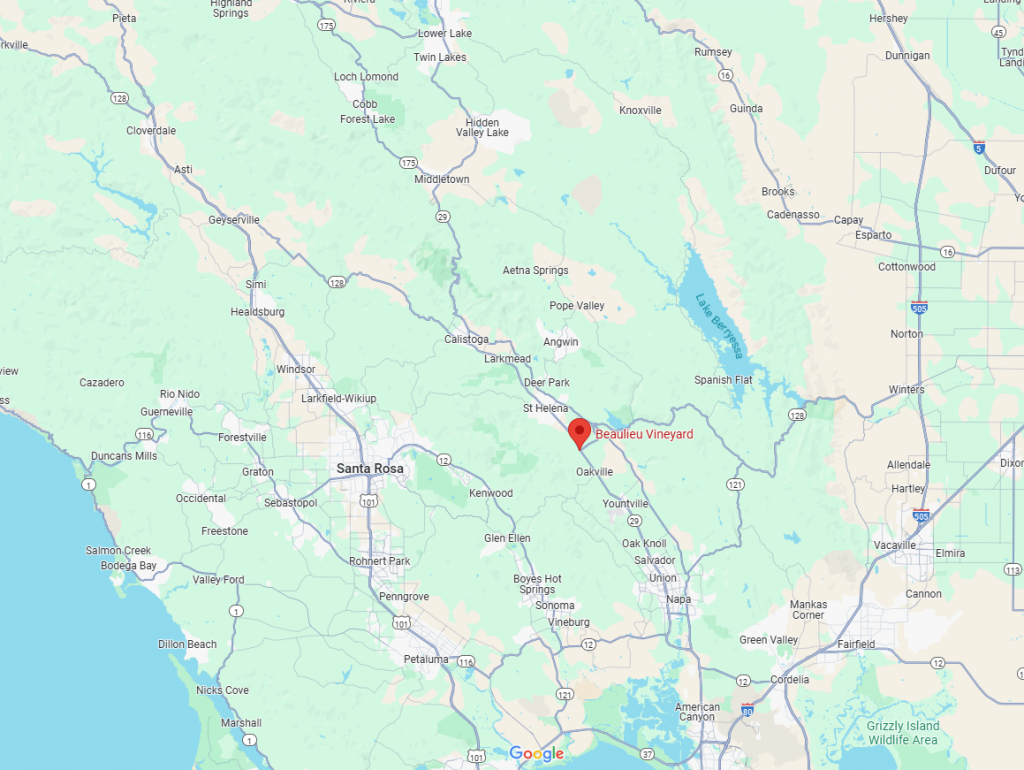Located in the center of Napa Valley, Beaulieu Vineyard (BV) is a testament to the craft and heritage of winemaking. Since its founding in 1900 by Georges and Fernande de Latour, BV has continuously combined innovation with traditional methods to create wines that are both unique and long-lasting. With more than a century of existence, the vineyard has established itself as a standard for high-end wines, especially its well-known Cabernet Sauvignons. This article explores the complex methods and ideologies that characterize Beaulieu Vineyard’s winemaking craft.
Beaulieu Vineyards on Google Maps

The Heritage of Tradition and Innovation
The philosophy that underpins Beaulieu Vineyard’s winemaking journey combines a dedication to innovation with a reverence for heritage. In 1900, French immigrant Georges de Latour established the vineyard, intending to introduce Old World winemaking methods to Napa Valley’s rich soils. Fernande’s initial reaction upon seeing the area inspired the name “Beaulieu,” which translates to “beautiful place” in French.
As one of the few California wineries to prosper during Prohibition by making sacramental wine, BV immediately established a reputation for excellence in its early years. In addition to protecting the vineyard, this crucial time solidified its reputation as a significant figure in American winemaking history.
Georges de Latour’s visionary strategy ensured BV remained ahead of its curve. He employed André Tchelistcheff, a Russian-born enologist who would go on to become one of the most important people in American winemaking, in 1938 because he understood the value of expertise. Tchelistcheff dubbed the “Dean of American Winemaking,” popularised revolutionary methods like cold fermentation, tiny French oak barrels, and strict hygienic regulations. These developments raised the bar for quality in Napa Valley and brought BV’s wines to a global audience. Beyond BV, Tchelistcheff’s impact shaped the development of winemaking in the area and served as an inspiration to succeeding generations of vintners.
Careful Vineyard Administration
Careful vineyard management is at the core of Beaulieu Vineyard’s winemaking process. The estate has more than 1,100 acres in a variety of terroirs in the Napa Valley, including the renowned Rutherford Bench, which is renowned for its perfect growing conditions for Cabernet Sauvignon. The well-draining alluvial soils of the Rutherford Bench are made up of silt, sand, and gravel that the Napa River has deposited over many millennia. These soils promote the development of deep roots, which leads to vines that yield grapes with well-balanced tannins and rich flavors.
Beyond the Rutherford Bench, BV’s vineyards may be found in several Napa Valley sub-appellations, each with its own distinct soil composition. Clay-based soils provide the depth and structure of the wine, while volcanic soils, which are rich in minerals, add intensity and complexity. Because of these different soil types, BV can grow a broad variety of grapes, such as Chardonnay, Sauvignon Blanc, and Semillon for their white wines and Cabernet Sauvignon, Merlot, Petit Verdot, and Malbec for their red wines. Every variety is meticulously paired with its perfect terroir to guarantee the best possible flavor and quality expression.
To maintain the quality of the fruit and the well-being of the land, BV uses sustainable agricultural methods. Grape quality is increased while the environmental effect is reduced through the use of practices including integrated pest management, drip irrigation, and cover crops. Precise harvesting at optimal maturity is made possible by the meticulous monitoring and management of every vineyard block.
The Winemaking Process: Care and Enthusiasm
At Beaulieu Vineyard, winemaking is an art as well as a science. Hand harvesting, a time-consuming procedure that guarantees only the best fruit is chosen, is the first step in the process. The grapes are carefully sorted to eliminate any flaws as soon as they get to the winery.
The winemaking crew can keep a close eye on and direct the fermentation process because it takes place in temperature-controlled stainless steel tanks. In order to extract the desired flavors, colors, and tannins from the grapes, this procedure is essential. Extended maceration is frequently used to improve the complexity and structure of red wines.
The use of French oak barrels for aging is a distinctive aspect of BV’s winemaking. These barrels enhance the wine’s inherent qualities by adding delicate hints of vanilla, spice, and toasted oak. Depending on the varietal and style, the aging period varies; some wines require more than two years in oak barrels to develop their distinctive depth and finesse.
Signature Wines: An Exhibition of Quality
The portfolio of Beaulieu Vineyard demonstrates its dedication to quality. The flagship wine and a testament to Napa Valley’s winemaking prowess is the Georges de Latour Private Reserve Cabernet Sauvignon, which was first produced in 1936. Made from the Rutherford estate’s best grapes, this wine is renowned for its deep, black fruit flavors that are complemented by hints of cocoa, espresso, and baking spices.
Other noteworthy products include the Maestro Collection, a line of limited-edition wines that highlight the vineyard’s creativity and experimentation, and the Tapestry Reserve, a Bordeaux-style blend that epitomizes harmony and balance.
The Tasting notes